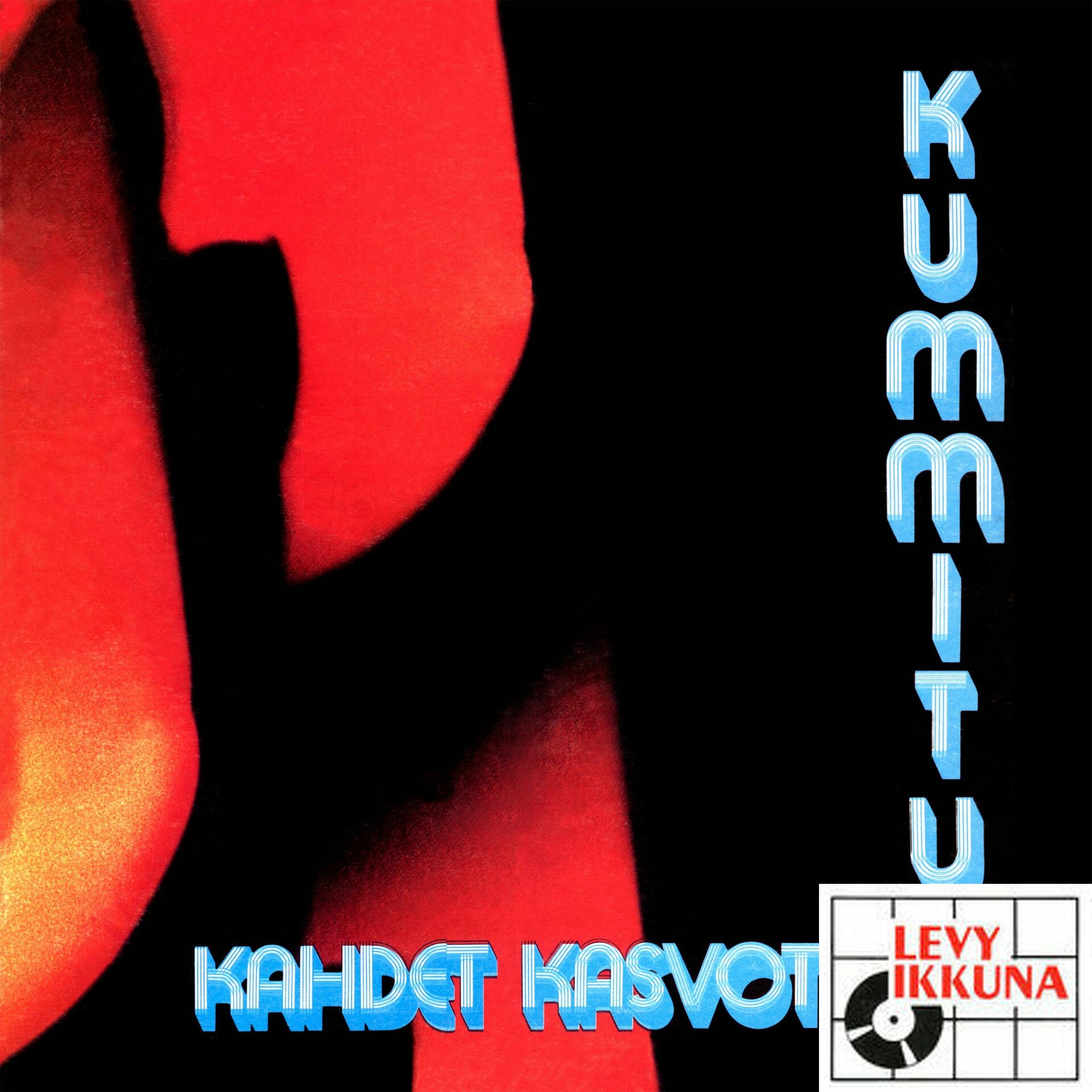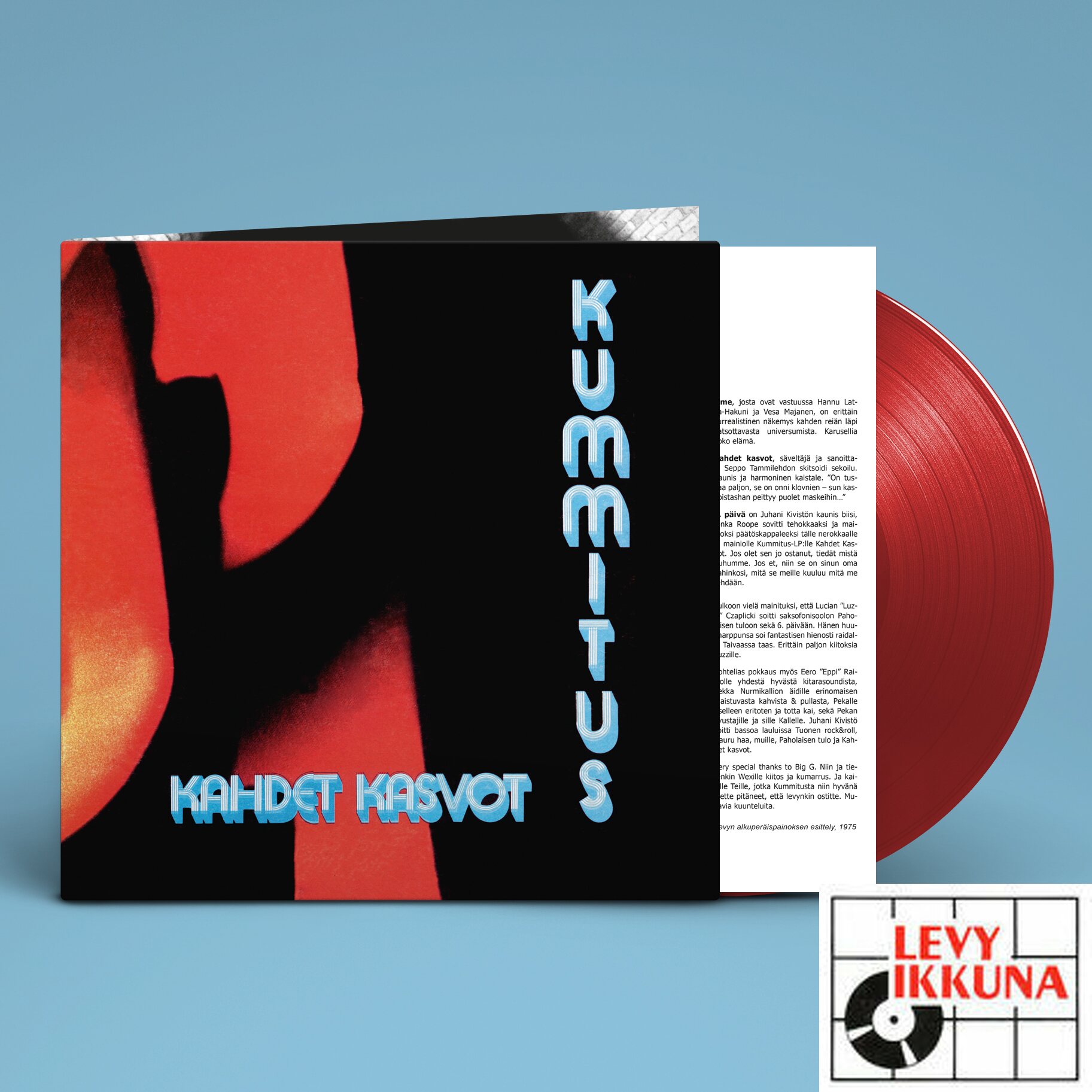Produkterne» LP-LEVYT» PROGE»
Kummitus – Kahdet Kasvot LP Coloured Vinyl
Tilgængelighed
Umiddelbart
Lagerbeholdning
Produktbeskrivelse
Limited red vinyl, gatefold sleeve
Kummitus (Finnish for “Ghost”), a band from Tampere who were active in the mid- ’70s, is certainly one of the strangest entities in the history of Finnish rock music. Their original vision was to create a mystical band that builds on horror or hysteria and performs in costumes, frightening their live audience. The band had also considered remaining completely anonymous. However, the concept proved inadequate for various reasons. Keyboardist Hannu Latva-Hakuni recalls: “We quickly ditched the masks and costumes because we had to show up before the show during the load in.” Drummer Seppo Tammilehto has speculated that in the ’70s, musical skills were even more important than in later eras of rock music. “We were laughed off the stage because of these extra musical elements.”
The concept for Kummitus came from Heikki Kauppinen who had managed a booking agency called Ohjelmamiehet and sold Matthews’ gigs. “He proposed this idea to me in the very beginning”, Seppo Tammilehto recalls. Jussi Niemi from the town of Nokia became the band’s guitarist. Despite their young age, Niemi and company accompanied both Sammy Babitzin and Johnny Liebkind and played in Muska’s band for one summer. A stint in Arto Sotavalta’s Häkäpönttö was followed by military service. After that also Niemi had time to play in Matthews. “Then we moved on to plan Kummitus.”
As the band’s manager, Heikki Kauppinen designed Kummitus a light show together with Pekka Heinänen who was responsible for the costumes. Flyers saying “KUMMITUS IS COMING” were distributed all over Finland. When the band hit the road in the summer of 1975, the light show was of course ruined by sunshine. Besides their then unreleased original material, Kummitus played cover songs mainly from British rock bands such as Rolling Stones and The Beatles.
Later on Heikki Kauppinen was contacted by Kari Kantalainen and Vesa Majanen, both coming from a journalist background, who wanted to produce Kummitus’ album. The record label BASF, who were more renowned for their cassette tapes fit for home recording, was found through Kauppinen’s contacts. The album was made in Pekka Nurmikallio’s Microvox studio in Lahti. Jussi Niemi recalls there being “two stereo recorders, so almost everything was played live. Even the choir sections were sung while we were playing. The vocals, however, were recorded separately. It was challenging, since there’s all sorts of soundscapes especially on side B.”
True to its name, Kahdet kasvot (Two Faces) clearly consists of two different sides. The straightforward and rocking side A is kicked off with ‘Paranoia’, composed by Niemi and featuring lyrics written by Tammilehto. The murky synth parts are a fine addition to the “robust rock music”, as the original pressing’s liner notes describe the song. As an uptempo rock song, Juhani Kivistö’s ‘Tuonen rock & roll’ may bring to mind early Coitus Int, whereas ‘Taivaassa taas’ and its devoted vocal performances share DNA with Kontra’s Finnrock. ‘Nauru haamuille’, written by Tammilehto, features proggy guitar patterns and a ghastly synth solo. ‘Se on ok’ was written by Niemi while the rest of the band was dining, with the purpose of making the album long enough to be sold at a full price.
The more experimental four-part entity of side B was, according to the liner notes, dedicated to “Spike Jones and an Englishman named Waters.” Pink Floyd influences are apparent in dramatic sound effects and certain details in the arrangements. ‘On the Run’ from The Dark Side of the Moon can be seen as one of the role models for the nightmarish track ‘Ilme’. The title track, written and sang by Tammilehto, is a catchy rock composition, and Kivistö’s ‘Kuudes päivä’ effectively mixes Floydian prog and blues nuances with saxophone-filled soul. The guest blower Lucjan Czaplicki played in Uranus, whose sole album Aamun hauta (1975) was also released by BASF.
The story of Kummitus continued for a while, albeit with obscure twists. “Due to certain difficulties, the band split up in the early summer of 1976,” Seppo Tammilehto recounts. “The group continued with a lineup that consisted of me, Olli Kivistö and Eero Peltonen. We backed up Mikko Alatalo under the moniker Manserock-76. This came to an end late in the summer when I reassumed the position of Alwari Tuohitorvi’s drummer. The group had become quite popular.” After the original Kummitus had split up, some other individuals played gigs under the moniker. Seppo Tammilehto has met a recently deceased musician and person of reduced mobility from Tampere, named Jukka Törmä, who used to play in the fake group. “With all due respect, he was a great guy. Törmä looked back on the gigs, where musicians were gathered before the performances, with a smile even if they didn’t work out at all. Kummitus’ manager Heikki Kauppinen had no idea who was arranging these shows. According to Törmä, the shows weren’t arranged for long and he stepped aside quite early.”
Even without the band’s unusual history, Kahdet kasvot would deserve a second coming as an original and interesting album. To cite Hannu Latva-Hakuni, “listening to the album now, almost 50 years later, I think we did a hell of a good job.”
Tracklist:
A1. Paranoia 2:42
A2. Tuonen Rock & Roll 2:18
A3. Taivaassa Taas 3:14
A4. Unikuva 2:48
A5. Nauru Haamulle 3:08
A6. Se On Ok 2:06
B7. Paholaisen Tulo
B8. Ilme
B9. Kahdet Kasvot
B10. 6. Päivä
Label: Svart Records
Released: 1976/2022
KommentarerTilføj kommentar
Umiddelbart
Lagerbeholdning
Produktbeskrivelse
Kummitus – Kahdet Kasvot
Limited red vinyl, gatefold sleeveKummitus (Finnish for “Ghost”), a band from Tampere who were active in the mid- ’70s, is certainly one of the strangest entities in the history of Finnish rock music. Their original vision was to create a mystical band that builds on horror or hysteria and performs in costumes, frightening their live audience. The band had also considered remaining completely anonymous. However, the concept proved inadequate for various reasons. Keyboardist Hannu Latva-Hakuni recalls: “We quickly ditched the masks and costumes because we had to show up before the show during the load in.” Drummer Seppo Tammilehto has speculated that in the ’70s, musical skills were even more important than in later eras of rock music. “We were laughed off the stage because of these extra musical elements.”
The concept for Kummitus came from Heikki Kauppinen who had managed a booking agency called Ohjelmamiehet and sold Matthews’ gigs. “He proposed this idea to me in the very beginning”, Seppo Tammilehto recalls. Jussi Niemi from the town of Nokia became the band’s guitarist. Despite their young age, Niemi and company accompanied both Sammy Babitzin and Johnny Liebkind and played in Muska’s band for one summer. A stint in Arto Sotavalta’s Häkäpönttö was followed by military service. After that also Niemi had time to play in Matthews. “Then we moved on to plan Kummitus.”
As the band’s manager, Heikki Kauppinen designed Kummitus a light show together with Pekka Heinänen who was responsible for the costumes. Flyers saying “KUMMITUS IS COMING” were distributed all over Finland. When the band hit the road in the summer of 1975, the light show was of course ruined by sunshine. Besides their then unreleased original material, Kummitus played cover songs mainly from British rock bands such as Rolling Stones and The Beatles.
Later on Heikki Kauppinen was contacted by Kari Kantalainen and Vesa Majanen, both coming from a journalist background, who wanted to produce Kummitus’ album. The record label BASF, who were more renowned for their cassette tapes fit for home recording, was found through Kauppinen’s contacts. The album was made in Pekka Nurmikallio’s Microvox studio in Lahti. Jussi Niemi recalls there being “two stereo recorders, so almost everything was played live. Even the choir sections were sung while we were playing. The vocals, however, were recorded separately. It was challenging, since there’s all sorts of soundscapes especially on side B.”
True to its name, Kahdet kasvot (Two Faces) clearly consists of two different sides. The straightforward and rocking side A is kicked off with ‘Paranoia’, composed by Niemi and featuring lyrics written by Tammilehto. The murky synth parts are a fine addition to the “robust rock music”, as the original pressing’s liner notes describe the song. As an uptempo rock song, Juhani Kivistö’s ‘Tuonen rock & roll’ may bring to mind early Coitus Int, whereas ‘Taivaassa taas’ and its devoted vocal performances share DNA with Kontra’s Finnrock. ‘Nauru haamuille’, written by Tammilehto, features proggy guitar patterns and a ghastly synth solo. ‘Se on ok’ was written by Niemi while the rest of the band was dining, with the purpose of making the album long enough to be sold at a full price.
The more experimental four-part entity of side B was, according to the liner notes, dedicated to “Spike Jones and an Englishman named Waters.” Pink Floyd influences are apparent in dramatic sound effects and certain details in the arrangements. ‘On the Run’ from The Dark Side of the Moon can be seen as one of the role models for the nightmarish track ‘Ilme’. The title track, written and sang by Tammilehto, is a catchy rock composition, and Kivistö’s ‘Kuudes päivä’ effectively mixes Floydian prog and blues nuances with saxophone-filled soul. The guest blower Lucjan Czaplicki played in Uranus, whose sole album Aamun hauta (1975) was also released by BASF.
The story of Kummitus continued for a while, albeit with obscure twists. “Due to certain difficulties, the band split up in the early summer of 1976,” Seppo Tammilehto recounts. “The group continued with a lineup that consisted of me, Olli Kivistö and Eero Peltonen. We backed up Mikko Alatalo under the moniker Manserock-76. This came to an end late in the summer when I reassumed the position of Alwari Tuohitorvi’s drummer. The group had become quite popular.” After the original Kummitus had split up, some other individuals played gigs under the moniker. Seppo Tammilehto has met a recently deceased musician and person of reduced mobility from Tampere, named Jukka Törmä, who used to play in the fake group. “With all due respect, he was a great guy. Törmä looked back on the gigs, where musicians were gathered before the performances, with a smile even if they didn’t work out at all. Kummitus’ manager Heikki Kauppinen had no idea who was arranging these shows. According to Törmä, the shows weren’t arranged for long and he stepped aside quite early.”
Even without the band’s unusual history, Kahdet kasvot would deserve a second coming as an original and interesting album. To cite Hannu Latva-Hakuni, “listening to the album now, almost 50 years later, I think we did a hell of a good job.”
Tracklist:
A1. Paranoia 2:42
A2. Tuonen Rock & Roll 2:18
A3. Taivaassa Taas 3:14
A4. Unikuva 2:48
A5. Nauru Haamulle 3:08
A6. Se On Ok 2:06
B7. Paholaisen Tulo
B8. Ilme
B9. Kahdet Kasvot
B10. 6. Päivä
Label: Svart Records
Released: 1976/2022
KommentarerTilføj kommentar


